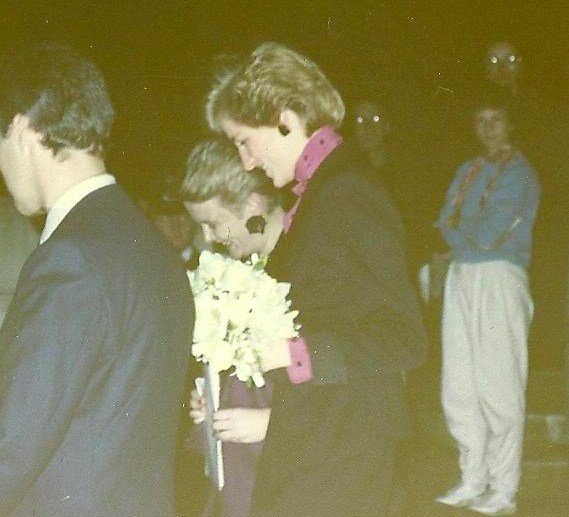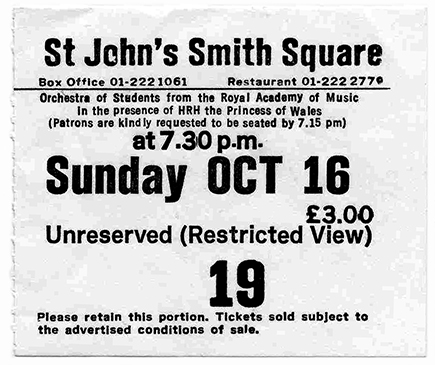An Evening with Princess Diana: October 16, 1988
When I was a sophomore in college, I attended Middlesex Polytechnic for one semester. Middlesex Poly was a public university in northern London (now called Middlesex University). Studying abroad was an adventure as much as it was an educational opportunity, and as it turned out class lessons were second to life lessons I learned that fall. Quite unexpectedly, one of those life lessons I learned from Princess Diana herself.
By chance, as I walked through central London one day, I saw a flyer advertising the annual appeal concert for the Royal Academy of Music, a performance arts high school. What caught my eye was a line of copy that noted the concert was, “In the presence of Her Royal Highness the Princess of Wales”—Princess Diana herself. The Royal Academy of Music was just one of the many organizations and causes she supported.
A friend and I went to the box office, which was in the basement of a beautiful old church. The church, St. John’s Smith Square, had been converted into a concert hall. We inquired about the Princess: Would she really be there? Where would she sit? What would she do? Tickets for reserved seats were expensive. Unreserved general admission seats, however, which were folding chairs placed along the outer perimeter of the nave area, were afforable. For £3.00 ($5.50) we bought tickets.
Disbelieving the event would actually occur—sure Her Royal Highness would come down with the flu or fall and break a leg, we made a pact not to tell anyone—anyone at all—about our plan. We didn’t want to jinx it. So for weeks, we anticipated the event with sealed lips, our general admission tickets safely tucked away.
When the afternoon of Sunday, October 16, 1988 arrived, we set off to St. John’s Smith Square, hoping to get a glimpse, even the most brief glance, of the glamorous Princess. I was attending with some other American students: Renee, Marcy, Kevin and Christopher. The five of us took the tube to Westminster Station and emerged from the underground at the base of Big Ben. We walked past Parliament and Westminster Abbey and continued three blocks south along the River Thames to the church. The anticipation was almost unbearable.
We arrived at 6:15, which was more than an hour before the concert was to begin. Our friend Robin, who also had a general admission ticket, met us there. I was amazed to discover the sidewalks were already filled with paparazzi and onlookers. Excitement permeated the air. For the next hour we watched the crowd grow, security guards on motorcycles come and go, and blue-suited bobbies monitoring the crowd. One bobbie, taken with our beautiful friend Robin, chatted with our small group the entire time we waited.
At 7:00 Renee, Kevin and Christopher went inside; they were concerned about getting good seats. Marcy, Robin and I, on the other hand, wanted to watch the Princess arrive. Shortly after, however, our bobbie, initially unaware we had tickets, informed us we had better go inside. He explained that once Her Royal Highness walked in, the doors would close behind her. I was crestfallen, figuring I had just lost my best chance to see her. Heeding his advice, we proceeded inside, went through a brief security check and claimed the only remaining folding chairs: chairs in the back corner where the side wall curved into the back wall. I immediately realized that a large pillar was directly in my line of sight to where the future queen would sit. There was no place to move; the only other unclaimed folding chair was marked ‘reserved.’ I was devastated.
The man to my right introduced himself, and we began chatting as sounds of the orchestra warming up filled the air. The man was a Professor of music at the University of London and started pointing out well-known figures in the music world. “That man in the tuxedo walking right there,” he said as he discreetly pointed, “is Mark Wigglesworth.”
I knew who that was! Mr. Wigglesworth was the director of the English National Opera! And standing a few rows in front of him, in a crimson velvet dress, was the woman I recently saw perform the lead role in “Carmen.” And just beyond her was a world-famous violin player, the Professor noted. This was an event that the Professor had attended many times, yet he seemed as giddy as I was.
To the Professor’s right was an older man who looked like he had walked in off the street. He wore tattered green trousers with a mismatched plaid shirt and old, dirty boots. He looked three months overdue for a haircut and a week overdue for a shave. The man sat silently, looking down at the floor as the black tie crowd paraded past him—past us—on their way to their expensive reserved seats.
While not dressed up, I had on the best I had with me in England: black trousers, a crisp white shirt and a cabled emerald green cardigan. I knew I was underdressed, but felt confident I did the best I could. And I thought to myself that at least I looked respectable.
As the professor continued to point out the famous and talented people in the crowd, the orchestra continued to warm up. Eager sounds filled the cathedral.
Promptly at 7:30 the orchestra got into position and the church became silent. We stood. The sound of the crowd outside announced she had arrived. Princess Diana walked in through the huge, wooden double doors on the side wall down from where we stood. At a distance of 20 yards I could hear the sound of her heels on the floor and the shutter clicking on the single camera documenting the events inside. That is how quiet it was. The doors shut behind her as promised. She walked forward, shook hands and accepted a bouquet of yellow and white flowers from a student representative and proceeded forward to the single, stuffed armchair in the center of the front row. She sat down and a split-second later we all sat in unison.
Seconds later the orchestra started playing the synchronized melody of Bach’s Brandenburg Concerto No. 5.
I breathed again.
I discovered that by leaning to my right, almost but not quite touching the Professor, I could see around the pillar, through the crowd and see her ear and the collar of her perfectly tailored black suit coat. At times I could also see a flash of her bright pink blouse. Looking around the church as the Concerto continued, I noticed that one of the Princess’ Ladies in Waiting had taken a seat along the wall with us, in the folding chair that had been reserved just for her. She was seated just beyond the man in the tattered green trousers. Her proper posture, immaculate grooming and unwrinkled clothing provided an unmistakable contrast to his presence. I’m sure she noticed as well.
When the first half of the concert was done, as the crowd clapped, the Princess stood. We all stood. I tried to see what was happening through the crowd, but could not. But I heard movement.
Suddenly she appeared. She started walking toward us. The Princess was walking down the narrow aisle between the pews and the line of folding chairs along the wall. My brain did some slow-motion processing: if she kept walking straight she had to walk right in front of me (…where else would she have gone? Who knows! My brain wasn’t working well in that moment…). I could hardly breathe. The crowd was silent. Again, you could hear her footsteps. As she strode forward I noticed how tall and thin and graceful she was. She smiled and made eye contact with people. She was not like the rest of us.
Suddenly, as she almost reached a point directly in front of me, she stopped and turned. Her body guard, who had been walking a half pace behind on her left, stepped out of the way. She faced the folding chairs.
“Hello,” she said in a soft and familiar tone, “it’s good to see you again. How are you?”
I was stunned. I had hoped—at most—to see a glimpse of her, and now she stood a half pace to my right carrying on a personal conversation. I’m sure my jaw dropped.
“I am well, thank you,” a sure but quiet voice replied.
I turned to look at the Professor, surprised he had not told me that he knew the Princess. Although I hardly knew this man, I felt betrayed—slighted—that he hadn’t disclosed their familiarity.
“Did you enjoy the concert?” Diana gently asked.
But to my surprise, the reply came from the man directly beyond him. The dirty, poorly dressed man in tattered clothes.
“Very much so,” he responded properly. “And you?”
“Oh, yes. I thought it was wonderful.” She smiled at him. And after a pause, she continued, “Good to see you. Take care.”
The man nodded and proudly smiled.
She turned back around and as she continued walking she made eye contact with each of us. At the very moment my eyes met hers I felt the hair on the back of my neck raise. Marcy, who stood to my left, lilted her head in a bow (something that hadn’t occurred to me to do).
In a few more paces, just two chairs beyond Robin, Diana disappeared through a single door, followed by her bodyguard, the principal section leaders of the orchestra and a few others. The moment the door shut behind them the church erupted in conversation. We collapsed into our seats. Marcy, Robin and I looked at each other in disbelief. We didn’t even speak. Renee and Christopher quickly came over to get the details about what had just happened on our side of the hall.
After ten or so minutes, one by one, the students came out of the back room, cradling their instruments. Their eyes sparkled. I knew that feeling.
As I looked around the church the man in the tattered clothes caught my eye. He sat there silently, proudly and alone. But now he held his head high. I desperately wanted to ask him how he knew the Princess, but I couldn’t. I felt ashamed. I had judged him and I could not bring myself to speak with him just because the Princess had. Embarrassed by my thoughts, I had to look away.
Soon after, people reclaimed their seats and the hall became quiet. Everyone stood. The door to the anteroom opened, and the Princess walked out for the second half. She again walked the aisle in front of us. With her bodyguard still on her left side, she was even closer to us than she had been before and I had the thought: if I bring my arm up even slightly I could touch her. But I wouldn’t dare. As she passed directly in front of me I looked down. It began as a Marcy-inspired bow, but I noticed something as I looked down. I saw exactly where her foot was placed and realized I could unquestionably state how close we were by counting and measuring the black and white tiles: her foot was less than two feet away—closer to 18 inches. And as she passed, as if our senses weren’t filled already, I could feel the air move and in that air you could smell her perfume. It was Fendi perfume, Robin said afterward.
Her Royal Highness took her seat. We sat in response, and the second half of the concert began. If I leaned to my right to see around the pillar, I could catch another glimpse of her ear, her collar, her hair. And as I did I tried to convince myself that I really had been so close to her.
The second half was an operetta, Mahler’s “Das Lied von der Erde,” sung by Jean Rigby and Arthur Davies. As much as I enjoyed opera, I couldn’t wait for the concert to be over. I couldn’t wait to be free. I was bursting with excitement and wanted to talk about what had just happened. And yet at the same time I felt ashamed. Ashamed that I thought I was better than the man in the tattered green trousers.
When the concert ended, Diana again walked past us to the anteroom. She again looked us in the eyes and smiled. Again, the hair on my neck stood on end.
As she waited in the anteroom we exited the cathedral and stood on the marble stairs leading down from the church’s side entrance, taking places next to the paparazzi and the crowd of onlookers. Before long, Diana walked out, flowers in hand, illuminated by hundreds of photo flashes. She shook hands with a representative of the school, then gracefully bent into the back seat of a navy blue Jaguar. The chauffeur sped away, escorted by a legion of security guards on motorcycles.
Within minutes of her departure everyone was gone: the Professor, the rich, the famous, the Lady in Waiting, the paparazzi, the police, the orchestra and the man in the tattered green trousers. Everyone disappeared into the night. Everyone except the six of us. We lingered on the marble stairs of St. John’s Smith Square for an hour—shocked, excited, elated and reliving every detail.
Yet, combined with that excitement I still felt shame. Of all the rich, talented and beautiful people in attendance, the most famous woman in the world chose to stop and talk with the lowliest person there. With that brief conversation, she had the power to make him feel like the most important person in the room.

After the concert: Princess Diana is walking down the steps of St. John’s Smith Square. October 16, 1988.
.
———
Note: I originally wrote this essay ten or so years ago. I made a few small grammar and style revisions before posting it here.


Theresa Leffler
December 1, 2020 at 3:55 amCarolyn what a wonderful memory and what a lovely story of her good well to others. Thanks for sharing and hope all is well with you guys.